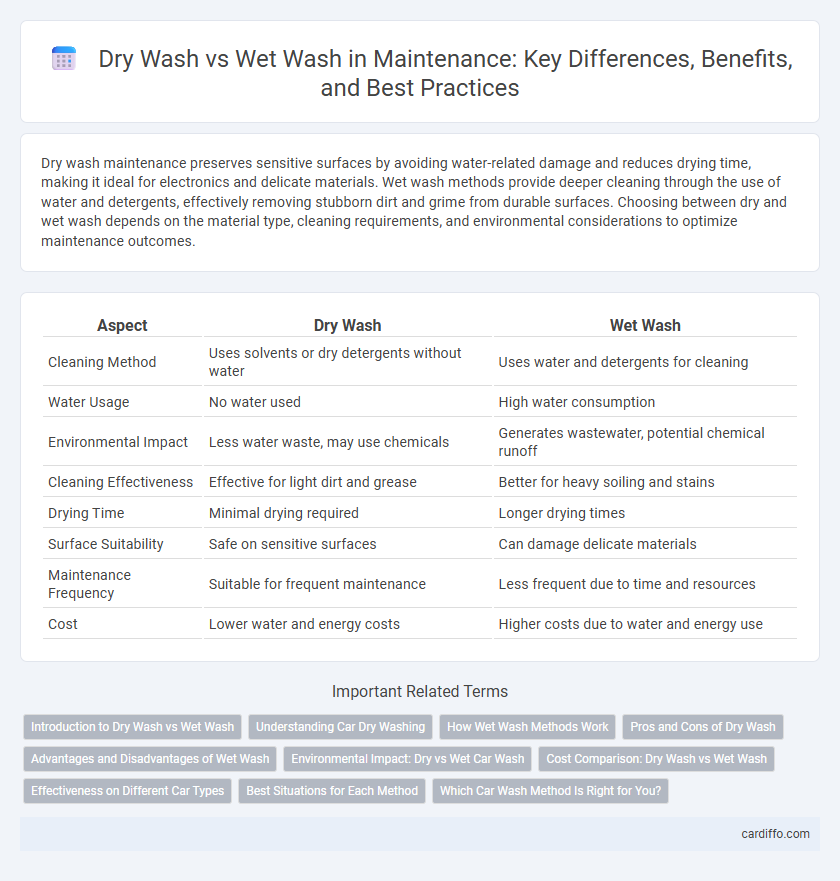Dry wash maintenance preserves sensitive surfaces by avoiding water-related damage and reduces drying time, making it ideal for electronics and delicate materials. Wet wash methods provide deeper cleaning through the use of water and detergents, effectively removing stubborn dirt and grime from durable surfaces. Choosing between dry and wet wash depends on the material type, cleaning requirements, and environmental considerations to optimize maintenance outcomes.
Table of Comparison
| Aspect | Dry Wash | Wet Wash |
|---|---|---|
| Cleaning Method | Uses solvents or dry detergents without water | Uses water and detergents for cleaning |
| Water Usage | No water used | High water consumption |
| Environmental Impact | Less water waste, may use chemicals | Generates wastewater, potential chemical runoff |
| Cleaning Effectiveness | Effective for light dirt and grease | Better for heavy soiling and stains |
| Drying Time | Minimal drying required | Longer drying times |
| Surface Suitability | Safe on sensitive surfaces | Can damage delicate materials |
| Maintenance Frequency | Suitable for frequent maintenance | Less frequent due to time and resources |
| Cost | Lower water and energy costs | Higher costs due to water and energy use |
Introduction to Dry Wash vs Wet Wash
Dry wash uses minimal to no water, relying on specialized cleaning agents and microfiber cloths to remove dirt and grime efficiently, making it ideal for water conservation and quick maintenance. Wet wash involves the application of water combined with detergents or soaps, offering a thorough cleaning suitable for heavy dirt or stubborn stains on various surfaces. Choosing between dry wash and wet wash depends on the level of contamination, environmental considerations, and equipment or surface sensitivity.
Understanding Car Dry Washing
Car dry washing utilizes waterless cleaning solutions that encapsulate dirt particles, allowing for their safe removal without scratching the paint surface, making it ideal for vehicles with light to moderate dirt. This method reduces water consumption by up to 90% compared to traditional wet washing, promoting eco-friendly maintenance practices while maintaining vehicle shine. Dry washing products often contain lubricants and polymers that enhance gloss and provide a protective layer against environmental contaminants.
How Wet Wash Methods Work
Wet wash methods use water combined with detergents or cleaning agents to effectively remove dirt, grease, and contaminants from surfaces. The process often involves agitation, scrubbing, or high-pressure spraying to loosen and rinse away debris, ensuring thorough cleaning. Wet washing is particularly effective for heavy soiling and oily residues where dry wash techniques may be insufficient.
Pros and Cons of Dry Wash
Dry wash offers the advantage of water conservation and reduced risk of corrosion or paint damage compared to wet wash, making it ideal for delicate surfaces and environmentally sensitive areas. However, it may not effectively remove heavy dirt, grease, or stubborn stains, often requiring more frequent or supplementary cleaning sessions. Its convenience and mobility make it suitable for on-site maintenance but may compromise deep cleanliness achievable with wet wash methods.
Advantages and Disadvantages of Wet Wash
Wet wash offers superior deep cleaning by removing stubborn dirt and grime effectively from surfaces, making it ideal for heavy-duty maintenance tasks. It may cause longer drying times and increased risk of water damage or corrosion on sensitive materials. Proper use of detergents and adequate rinsing can mitigate residue buildup, but wet wash generally demands more careful handling compared to dry wash methods.
Environmental Impact: Dry vs Wet Car Wash
Dry car washing significantly reduces water consumption by using minimal or no water, helping conserve this vital resource and lowering runoff pollution. Wet car washes, especially those conducted at commercial facilities, often incorporate water treatment systems to mitigate environmental impact, yet they typically consume 40 to 60 gallons of water per wash. Choosing eco-friendly detergents and proper disposal methods in both practices enhances environmental sustainability and reduces harmful chemical discharge.
Cost Comparison: Dry Wash vs Wet Wash
Dry wash methods generally incur lower costs due to reduced water usage and minimal wastewater disposal fees, making them ideal for areas with water restrictions. Wet wash processes often involve higher expenses related to water consumption, detergent use, and potential environmental compliance costs. Businesses must weigh initial investment and operational expenses to determine the most cost-effective maintenance strategy.
Effectiveness on Different Car Types
Dry wash methods offer superior effectiveness for delicate finishes and vehicles with sensitive paintwork, minimizing water damage and swirl marks. Wet wash techniques excel in thoroughly removing stubborn dirt and road grime on larger vehicles like SUVs and trucks, ensuring deep cleaning. Choosing the right wash depends on the car type, with dry wash suited for compact and luxury cars, while wet wash benefits heavy-duty and off-road vehicles.
Best Situations for Each Method
Dry wash is best suited for delicate surfaces and electronic components where water exposure could cause damage or corrosion. Wet wash is ideal for heavy-duty cleaning tasks, such as removing grease, dirt, and stubborn stains from machinery and outdoor equipment. Selecting the appropriate method depends on the material's sensitivity and the level of grime to ensure effective maintenance without compromising the equipment's integrity.
Which Car Wash Method Is Right for You?
Dry wash car methods use specialized waterless cleaning solutions and microfiber cloths to remove dirt without water, making them ideal for areas with water restrictions or quick touch-ups. Wet wash techniques involve soap, water, and usually a hose or pressure washer, providing a deeper clean that removes stubborn grime and road salt, essential for maintaining paint health in harsher climates. Choosing the right car wash method depends on factors like environmental regulations, frequency of washing, and the level of dirt on your vehicle.
Dry wash vs wet wash Infographic

 cardiffo.com
cardiffo.com